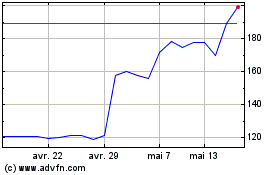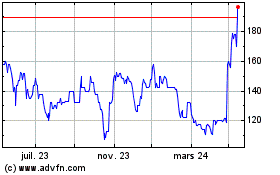When an operation is classified as a discontinued operation, the
comparative income statement is represented as if the operation had
been discontinued from the start of the comparative period.
Government grants
Capital-based government grants are included within other
financial liabilities in the balance sheet and credited to
operating profit over the estimated useful economic lives of the
assets to which they relate.
Expenses
Operating lease payments
Payments made under operating leases are recognised in the
income statement on a straight-line basis over the term of the
lease. Lease incentives received are recognised in the income
statement as an integral part of the total lease expense.
Finance lease payments
Minimum lease payments are apportioned between the finance
charge and the reduction of the outstanding liability. The finance
charge is allocated to each period during the lease term so as to
produce a constant periodic rate of interest on the remaining
balance of the liability.
Finance income and expenses
Finance expenses comprise interest payable, finance charges on
finance leases and unwinding of the discount on provisions and
deferred consideration. Finance income comprises interest
receivable on funds invested and dividend income.
Net movements in the fair value of derivatives are also included
within finance income or expense.
Interest income and interest payable is recognised in profit or
loss as it accrues, using the effective interest method. Dividend
income is recognised in the income statement on the date the
entity's right to receive payments is established. Foreign currency
gains and losses are reported on a net basis.
Taxation
Tax on the profit or loss for the year comprises current and
deferred tax. Tax is recognised in the income statement except to
the extent that it relates to items recognised in other
comprehensive income or directly in equity, in which case it is
recognised in other comprehensive income or equity
respectively.
Current tax is the expected tax payable on the taxable income
for the year, using tax rates enacted or substantively enacted at
the balance sheet date and any adjustment to tax payable in respect
of previous years.
Deferred tax is provided on temporary differences between the
carrying amounts of assets and liabilities for financial reporting
purposes and the amounts used for taxation purposes. The following
temporary differences are not provided for: the initial recognition
of goodwill; the initial recognition of assets or liabilities that
affect neither accounting nor taxable profit other than in a
business combination; and differences relating to investments in
subsidiaries to the extent that they will probably not reverse in
the foreseeable future. The amount of deferred tax provided is
based on the expected manner of realisation or settlement of the
carrying amount of assets and liabilities, using tax rates enacted
or substantively enacted at the balance sheet date.
A deferred tax asset is recognised only to the extent that it is
probable that future taxable profits will be available against
which the asset can be utilised.
Dividend distribution
Final dividends to shareholders of International Greetings plc
are recognised as a liability in the period that they are approved
by shareholders.
Employee benefits
Pensions
The Group operates a defined contribution personal pension
scheme. The assets of this scheme are held separately from those of
the Group in an independently administered fund. The pension charge
represents contributions payable by the Group to the fund.
The Netherlands subsidiary operates an industrial defined
benefit fund, based on average wages, that has an agreed maximum
contribution. The pension fund is a multi-employer fund and there
is no contractual or constructive obligation for charging the net
defined benefit cost of the plan to participating entities other
than an agreed maximum contribution for the period, that is shared
between employer (4/7) and employees (3/7). The Dutch Government is
not planning to make employers fund any deficits in industrial
pension funds; accordingly the Group treats the scheme as a defined
contribution scheme for disclosure purposes. The Group recognises a
cost equal to its contributions payable for the period.
Share-based payment transactions
The cost of equity-settled transactions with employees is
measured by reference to the fair value at the date on which they
are granted and is recognised as an expense over the vesting
period, which ends on the date on which the relevant employees
become fully entitled to the award. Fair value is determined by
using an appropriate pricing model. In valuing equity-settled
transactions, no account is taken of any service and performance
(vesting conditions), other than performance conditions linked to
the price of the shares of the Company (market conditions). Any
other conditions which are required to be met in order for an
employee to become fully entitled to an award are considered to be
non-vesting conditions. Like market performance conditions,
non-vesting conditions are taken into account in determining the
grant date fair value.
No expense is recognised for awards that do not ultimately vest,
except for awards where vesting is conditional upon a market
vesting condition or a non-vesting condition, which are treated as
vesting irrespective of whether or not the market vesting condition
or non-vesting condition is satisfied, provided that all other
non-market vesting conditions are satisfied.
At each balance sheet date before vesting, the cumulative
expense is calculated, representing the extent to which the vesting
period has expired and management's best estimate of the
achievement or otherwise of non-market vesting conditions and of
the number of equity instruments that will ultimately vest or, in
the case of an instrument subject to a market condition or a
non-vesting condition, be treated as vesting as described above.
The movement in cumulative expense since the previous balance sheet
date is recognised in the income statement, with a corresponding
entry in equity.
Borrowing costs
Borrowing costs directly attributable to the acquisition,
construction or production of an asset that necessarily takes a
substantial period of time to get ready for its intended use or
sale are capitalised as part of the cost of the respective assets.
All other borrowing costs are expensed in the period they occur.
Borrowing costs consist of interest and other costs that an entity
incurs in connection with the borrowing of funds.
New standards adopted early
The Group has elected to adopt early the amendments to IAS 36
Recoverable Amounts Disclosure for Non-Financial Assets.
New standards and interpretations not applied
Management continually reviews the impact of newly published
standards and amendments and considers, where applicable,
disclosure of their impact on the Group.
The following standards, interpretations and amendments issued
by the IASB have an effective date after the date of these
financial statements:
To be
Effective adopted by
New pronouncement date the Group
----------------------------------------------------------------------------------- ---------- ----------
IFRS 10 Consolidated Financial Statements 1 Jan 2014 1 Apr 2014
IFRS 11 Joint Arrangements 1 Jan 2014 1 Apr 2014
IFRS 12 Disclosure of Interests in Other Entities 1 Jan 2014 1 Apr 2014
IFRS 10, IFRS 12 and IAS 27 Investment Entities (Amendments) 1 Jan 2014 1 Apr 2014
IAS 32 Offsetting Financial Assets and Financial Liabilities - Amendments to IAS 32 1 Jan 2014 1 Apr 2014
IAS 39 Novation of Derivatives and Continuation of Hedge Accounting
- Amendments to IAS 39 1 Jan 2014 1 Apr 2014
IFRIC 21 Levies* 1 Jan 2014 1 Apr 2014
IAS 19 Defined Benefits Plans - Employee Contributions - Amendments to IAS 19* 1 Jan 2014 1 Apr 2014
Annual Improvements 2010-2012 Cycle* 1 Jul 2014 1 Apr 2015
Annual Improvements 2011-2013 Cycle* 1 Jul 2014 1 Apr 2015
IFRS 14 Regulatory Deferral Accounts* 1 Jan 2016 1 Apr 2016
Amendments to IAS 16 and IAS 38: Clarification of acceptable methods
of depreciation and amortisation* 1 Jan 2016 1 Apr 2016
Amendments to IFRS 11 Accounting for Acquisitions of Interest in Joint Operations* 1 Jan 2016 1 Apr 2016
IFRS 15 Revenue from Contracts with Customers* 1 Jan 2017 1 Apr 2017
IFRS 9 Financial Instruments* 1 Jan 2018 1 Apr 2018
----------------------------------------------------------------------------------- ---------- ----------
* Not yet endorsed by EFRAG.
IFRS 9 does not yet have a mandatory effective date. The IASB
have tentatively agreed an effective date of 1 January 2018.
None of the above standards are anticipated to significantly
impact the Group's results or assets and liabilities and are not
expected to require significant disclosure.
The new standards, interpretations and amendments which are
considered most relevant to the Group are as follows:
Ig Design (LSE:IGR)
Graphique Historique de l'Action
De Juin 2024 à Juil 2024

Ig Design (LSE:IGR)
Graphique Historique de l'Action
De Juil 2023 à Juil 2024
